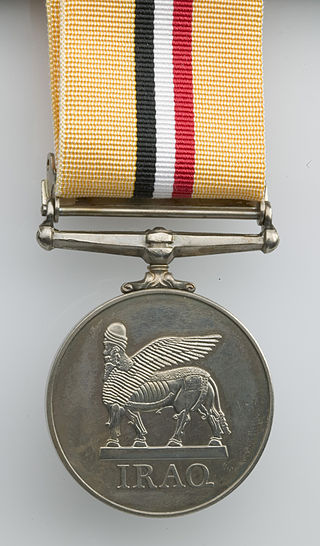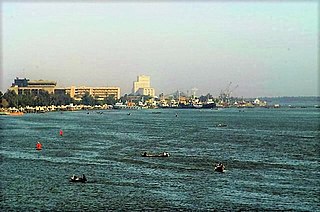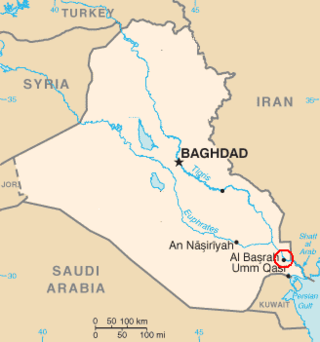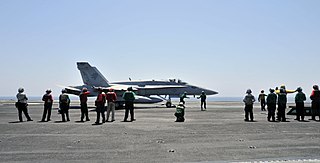Related Research Articles

This is a timeline of the events surrounding the United States-led invasion of Iraq in 2003.

The Occupation of Iraq (2003–2011) was characterized by a large United States military deployment on Iraqi territory, beginning with the US-led invasion of the country in March 2003 which overthrew the Ba'ath Party government of Saddam Hussein and ending with the departure of US troops from the country in 2011. Troops for the occupation came primarily from the United States, the United Kingdom, and Australia, but 29 other nations also provided troops, and there were varying levels of assistance from Japan and other countries, as well as tens of thousands of private military company personnel.

Operation Telic was the codename under which all of the United Kingdom's military operations in Iraq were conducted between the start of the invasion of Iraq on 19 March 2003 and the withdrawal of the last remaining British forces on 22 May 2011. The bulk of the mission ended on 30 April 2009 but around 150 troops, mainly from the Royal Navy, remained in Iraq until 22 May 2011 as part of the Iraqi Training and Advisory Mission. 46,000 troops were deployed at the onset of the invasion and the total cost of war stood at £9.24 billion in 2010.

The Mahdi Army was an Iraqi Shia militia created by Muqtada al-Sadr in June 2003 and disbanded in 2008.

The withdrawal of the United States troops from Iraq began in December 2007 with the end of the Iraq War troop surge of 2007 and was mostly completed by December 2011, bringing an end to the Iraq War. The number of U.S. military forces in Iraq peaked at 170,300 in November 2007.

The 7th Armoured Brigade was an armoured brigade formation of the British Army. The brigade is also known as the "Desert Rats", a nickname formerly held by the 7th Armoured Division, of which the brigade formed a part during the Second World War until late 1941.
The Household Cavalry Regiment (HCR) is an Armoured Cavalry regiment of the British Army based in Bulford Camp in Wiltshire. It is the brother regiment of the Household Cavalry Mounted Regiment (HCMR) based at Hyde Park Barracks in London - both regiments together form the Household Cavalry (HCav). The Household Cavalry Regiment was formed in 1992, under the Options for Change reforms, by the union of The Life Guards and The Blues and Royals in order to preserve the distinct identities of the regiments. A precedent for the Household Cavalry Regiment has previously been set by the Household Cavalry Composite Regiment - active during the Anglo-Egyptian War, the Second Boer War and latterly during both the First and Second World Wars.

Marshal of the Royal Air Force Graham Eric Stirrup, Baron Stirrup,, informally known as Jock Stirrup, is a former senior Royal Air Force commander who was the Chief of the Defence Staff from 2006 until his retirement in late 2010. He is now a Crossbench member of the House of Lords. In April 2013, he was appointed a Knight Companion of the Order of the Garter by Queen Elizabeth II.

The Multi-National Force – Iraq (MNF–I), often referred to as the Coalition forces, was a military command during the 2003 invasion of Iraq and much of the ensuing Iraq War, led by the United States of America, United Kingdom, Australia, Italy, Spain and Poland, responsible for conducting and handling military operations.

The 20th Armoured Brigade Combat Team, previously the 20th Armoured Infantry Brigade, is an armoured infantry brigade formation of the British Army, currently headquartered at Wing Barracks, Bulford, Wiltshire, as part of the 3rd Division.

Below is an estimated list of the major units deployed within the Multi-National Force – Iraq and other United States military units that were operating in Iraq under the U.S. Central Command (USCENTCOM) in 2009, during the Iraq War.

The Battle of Basra lasted from 21 March to 6 April 2003 and was one of the first battles of the 2003 invasion of Iraq. The British 7 Armoured Brigade fought their way into Iraq's second-largest city, Basra, on 6 April coming under constant attack by the Iraqi Army 51st Division and Fedayeen Saddam, while elements of the Parachute Regiment cleared the 'old quarter' of the city that was inaccessible to vehicles. Entering Basra had only been achieved after two weeks of conflict, which included the biggest tank battle of the war by British forces when the Royal Scots Dragoon Guards destroyed 14 Iraqi tanks on the 27 March.

The Battle of Basra was initiated by the Mahdi Army to capture the city of Basra in 2007. Following the reported major failure of the coalition forces, whose purpose was to stabilise Basra and prepare it for the turning over of security to Iraqi government forces, the city was overrun by insurgent forces from three different Iraqi factions including the Mahdi Army, and the British found themselves under major siege in their bases and capable of conducting only limited defence action in armoured convoys.

The Battle of Basra began on 25 March 2008, when the Iraqi Army launched an operation to drive the Mahdi Army militia out of the southern Iraqi city of Basra. The operation was the first major operation to be planned and carried out by the Iraqi Army since the invasion of 2003.
The Basra prison incident was an event involving British troops in Basra, Iraq.

General Sir Peter Anthony Wall, is a retired British Army officer who served as the Chief of the General Staff, the professional head of the British Army, until September 2014. Wall had previously been the Commander-in-Chief, Land Forces from August 2009 to September 2010. He succeeded General Sir David Richards as Chief of the General Staff in September 2010, the latter going on a month later to be Chief of the Defence Staff.

Lieutenant General Sir James Benjamin "Jim" Dutton, is a retired Royal Marines officer and former Governor of Gibraltar. He held various staff positions in his early career, before commanding 40 Commando. As a brigadier, he held two high-level staff posts—the first at the Ministry of Defence in London, as Director of NATO policy, and the second as a British liaison to The Pentagon shortly after the September 11 attacks, where he was involved in the planning for the subsequent invasion of Afghanistan.

Operation Shader is the operational code name given to the contribution of the United Kingdom in the ongoing military intervention against the Islamic State of Iraq and the Levant. The operation involves the British Army providing ground support and training to allied forces fighting against ISIL, the Royal Air Force providing humanitarian aid airdrops, reconnaissance and airstrikes, and the Royal Navy providing reconnaissance and airstrikes from the UK Carrier Strike group and escort to allied carrier battle groups.

On 15 June 2014, U.S. President Barack Obama ordered United States forces to be dispatched in response to the Northern Iraq offensive of the Islamic State (IS) as part of Operation Inherent Resolve. At the invitation of the Iraqi government, American troops went to assess Iraqi forces and the threat posed by ISIL.
References
Citations
- 1 2 3 4 5 6 7 8 9 10 11 12 13 14 15 16 17 18 19 20 21 22 23 24 25 26 27 28 29 30 31 32 33 34 35 36 37 "Operation Telic: British Forces Deployed". Britain's Small Wars. Archived from the original on 20 August 2014. Retrieved 17 November 2013.
- 1 2 "Iraq (Operation KIPION)". Royal Air Force . Retrieved 18 November 2013.
- ↑ "British Fatalities during Operation Telic" (PDF). Ministry of Defence. Archived from the original (PDF) on 13 May 2005. Retrieved 18 November 2013.
- ↑ "British forces hand over control of Basra airport to Americans". The Guardian . Retrieved 18 November 2013.
- 1 2 "Jubilant Iraqi looters strip military base after British forces pull out". The Telegraph. Retrieved 1 April 2020.
- ↑ "Looters Descend on Iraqi Camp After British Soldiers Pull Out". The LA Times. Retrieved 1 April 2020.
- ↑ "Troops back from long, hard combat". The Guardian. Retrieved 1 April 2020.
- ↑ "Troops try to reap the green shoots of freedom". The Telegraph. April 6, 2020.
- ↑ "Handover of Camp Chindit, Az Zubayr, 29 September 2005". IWM. April 6, 2020.
- ↑ "The Report of the al Sweady Inquiry" (PDF). HM Government. Retrieved 31 March 2020.
- ↑ "Camp Condor". IWM. Retrieved 31 March 2020.
- ↑ "UK begins Iraq farewell by saying: so long, and thanks for the fish". The Guardian. Retrieved 18 November 2013.
- ↑ "British forces withdraw from Basra Palace base". The Guardian. Retrieved 18 November 2013.
- ↑ Allen 2020, p. 6.
Bibliography
- Allen, G (2020). The Paras in Iraq - Operation Telic 1. UK: Key Books. ISBN 978-1-913295-90-5.